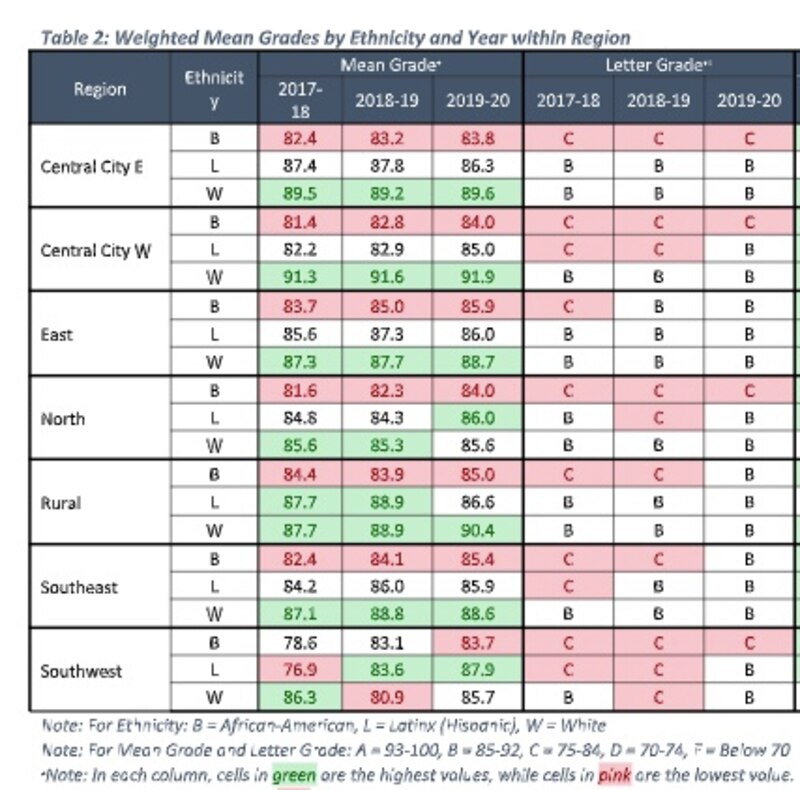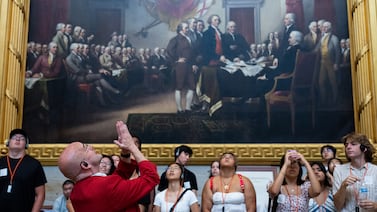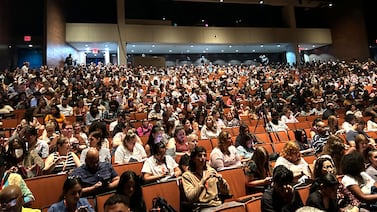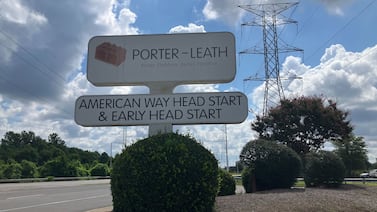Although they recognized their teachers’ efforts at fostering equity and inclusion, many students in Shelby County Schools struggled with a sense of belonging before the pandemic. These findings were part of the Equity and Inclusion Survey, a multi-year survey that included 9,737 responses from middle and high school students.
The survey was one segment of a comprehensive equity audit recently released by Shelby County Schools. At the request of school board members, scholars at the University of Memphis Center for Educational Research in Educational Policy conducted the audit by assessing district and state data from 2017 to 2020, before the pandemic.
University researchers completed the audit in December, said Michael Lowe, Shelby County Schools director of equity and access. Chalkbeat requested a copy of the audit in April, and district officials released it to Chalkbeat more than a month later. Officials added the audit as a topic of discussion to the agenda of a May committee meeting. Spanning more than 100 pages, the complete audit covers everything from the racial climate at Memphis schools to racial disparities in graduation rates. Here are some key findings:
Many Memphis students felt disconnected before the pandemic
In the year leading up to the pandemic, many Memphis middle and high school students felt disconnected from the students, faculty, and staff at their schools, according to a 2019 student survey.
When asked, “Overall, how much do you feel like you belong at your school?” 57% of students said they “completely belong” or “belong quite a bit.”
Washington, D.C., another urban district with a high population of economically disadvantaged students, had similar results. Fifty-eight percent of middle and high school students in D.C. public schools responded favorably in a 2019 survey using the same set of survey questions. Researchers at Harvard Graduate School of Education and Panorama Education created the survey to build a national dataset that measures diversity, equity, and inclusion at U.S. schools.
When asked, “How much do you matter to others at this school?” 43% of Memphis students said they “matter a tremendous amount” or “matter quite a bit” to educators and fellow students. The Memphis result was 5 percentage points lower than Washington, D.C. student responses.
In the section measuring sense of belonging, the most troubling number came in response to the question “How connected do you feel to the adults at your school?” Only 32% of Memphis students responded favorably with “extremely” or “quite” connected. By comparison, 38% of Washington, D.C. public school students responded favorably.
Since Memphis students felt a lack of belonging many months before the pandemic, that raises questions about how they weathered the mental health toll of virtual learning, social distancing, and school disruption. Due to the pandemic, officials did not administer the test in spring 2020 but did schedule the 2021 school year tests.
Memphis students give their schools and teachers high marks for diversity and fairness
Shelby County students gave their teachers and schools high marks for cultural awareness and diversity.
In the area of “cultural awareness and action,” more than 70% of students responded favorably to two questions: “At your school, how often are you encouraged to think more deeply about race-related topics?” and “When there are major news events related to race, how often do adults at your school talk about them with students?”
Of all the survey questions reviewed as part of the equity audit, the district had the highest marks in the area of fairness. Eighty-three percent of students said that adults at their school treat students of different races and cultures “extremely fairly” or “quite fairly.”
Steep gap between graduation rates of Black girls and Hispanic boys
In 2020, African American girls had the highest graduation rates in Shelby County Schools and Hispanic boys had the lowest graduation rates. The graduation rate among Black girls fell less than a percentage point during the pandemic in 2020, hovering around 85%. The state average was 89.6%.
However, the graduation rate for Hispanic boys fell from about 65% to 60%. Graduation rates across the state dipped slightly in 2020, and state officials are hopeful that numbers will rebound when the 2021 school year ends. The last day for Memphis schools is June 16.
The historic lag in Hispanic male graduation rates, followed by the sharp pandemic drop, raised concern among some school board members during a recent committee meeting.
“I know that we have our Black male initiative,” said school board member Sheleah Harris. “Have we started thinking about how we want to support our Hispanic males, because that’s the obvious lowest percentage?”
As the Hispanic population continues to climb in Memphis, improving graduation rates for Hispanic boys will be integral to the district’s goal of decreasing racial disparities. Lowe said the district recently held an event to attract bilingual teachers, a move that could help some Spanish-speaking students improve their English language skills and graduate.
Student achievement is uneven across neighborhoods and sags in North Memphis
To compare student achievement at a neighborhood level, University of Memphis researchers divided the district into seven regions, and the audit revealed that students in North Memphis have more academic struggles than students in other regions. Craigmont High, Memphis Business Academy High, Memphis Rise Academy, Raleigh-Egypt High, and Trezevant High were grouped in the North Memphis region.
Students of all races, except for Latino students, had lower GPAs in North Memphis than students of the same race in other regions.
Black students in North Memphis also performed worse on the ACT than Black students in other neighborhoods, averaging a 14.5 ACT score. The state average is 20. African American and Latino students fall short of that average in every region in the district, marking one of the racial disparities facing the district.
District-wide, African American students also receive the lowest letter grades.
As the report notes, “By 2019-20, means for African-American students were in the high C to low B range, while means for Latinx students were in the low to mid B range, and means for White students were in the low to high B range.”

The survey did not separately track grade distribution for students of Asian descent, Indigenous students, and multiracial students.
After district officials shared part of the data from the equity audit at a recent school board committee meeting, board members had several questions, but the most pressing question was what happens next?
“A report is nothing if we’re not going to take the information that we have and do things differently,” said school board member Stephanie Love.
She added that some of the findings in the equity audit have been well-known trouble spots in the district for years.
“We knew this,” she said. “Now we have the data to show this. Now I need to know what we are going to do about this?”
The 30-minute presentation and discussion in May only delved into a sliver of the more than 100-page equity audit. Board members will meet again in June to discuss other sections of the report.







